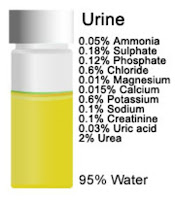
Tuesday, May 26, 2009
Evidence for Continental Drift

Tuesday, May 19, 2009
Journey to the Center of the Earth

Tuesday, May 12, 2009
The Atmosphere

Tuesday, May 05, 2009
Frogs!!!
Monday, April 27, 2009
Animal skins
Monday, April 13, 2009
Excretory System
 You've just learned how the kidneys filter blood in the microscopic units called nephron. Wastes such as urea form urine which travels from the kidneys to the urinary bladder by way of the ureters. From the bladder, urine travels through the urethra out of the body. Do other animals produce urine in the same way?
You've just learned how the kidneys filter blood in the microscopic units called nephron. Wastes such as urea form urine which travels from the kidneys to the urinary bladder by way of the ureters. From the bladder, urine travels through the urethra out of the body. Do other animals produce urine in the same way?
Choose any animal and research how that animal filters wastes out of its body. Do they have kidneys or another organ that does the same job?
Tuesday, April 07, 2009
Diseases of the heart and lungs
So far in our Human Body Systems unit, we have studied the skeletal, muscular, digestive, circulatory and respiratory systems. You have learned all about how these systems work when everything functions normally, ie when you're healthy. What happens when something doesn't work right, when you're ill? Find out about one disease or disorder that affects one of these systems. Explain what doesn't work right and how doctor's treat the problem.
Examples - Skeletal: osteoporosis, scoliosos, bone cancer
Muscular: Muscular distrophy, fibromyalgia,
Digestive: stomach ulcers, Krohn's Disease, diverticulitis, stomach cancer
Circulatory: leukemia, anemia, sickle cell anemia, aneurism
Respiratory: Emphysema, lung cancer, bronchitis

Monday, March 30, 2009
How does it get oxygen?
 All animals need oxygen for cellular respiration. Plants need oxygen, too. Most organisms do, although for some bacteria and archaeans oxygen is toxic. Humans are mammals, and like all mammals they use lungs to get oxygen out of the air. Find out about how other animals get oxygen for cellular respiration. Again, remember that invertebrates such as worms, snails and insects are also animals. Write 2 interesting facts about the respiration system of your animal choice.
All animals need oxygen for cellular respiration. Plants need oxygen, too. Most organisms do, although for some bacteria and archaeans oxygen is toxic. Humans are mammals, and like all mammals they use lungs to get oxygen out of the air. Find out about how other animals get oxygen for cellular respiration. Again, remember that invertebrates such as worms, snails and insects are also animals. Write 2 interesting facts about the respiration system of your animal choice.
Sunday, March 22, 2009
Blood Thirst!!

Do some research of your own about one of these animals or another type of sanguivore (blood eaters.) Write a short paragraph (5-6 sentences) about what you learned about them. Please no paragraphs on human vampires!
Thursday, March 12, 2009
Cardiovascular System


Wednesday, March 04, 2009
Digestive System

















